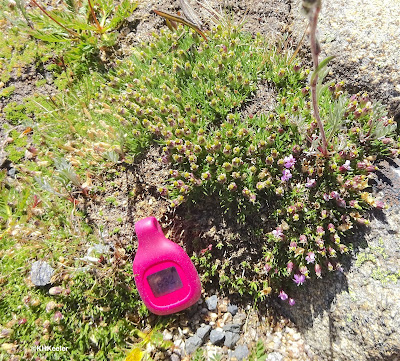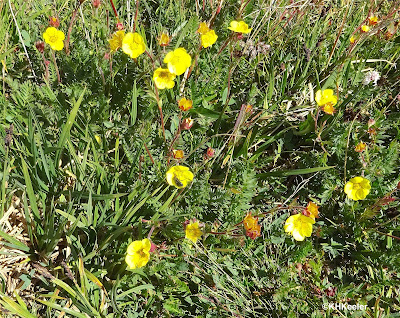Life is hard for plants of the alpine tundra (previous post link). Alpine tundra is the ecosystem above treeline, in the United States from about 10,000' elevation up. The growing season is short, about three months. Frosts occur most nights all year and snow can fall any day.
The soil is unstable as the water in it freezes (expanding) and thaws (contracting). The soil shifts and the rocks steadily move around. Plant roots are displaced, making them sprawl. There is little cover, thin atmosphere, and less distance to the sun, so sunlight is very strong, despite cool temperatures, making sun damage to tissues much more common than better-protected places.
High mountains are windy, often brutally so. Photos don't do it justice, here is a video.
Alpine tundra plants are low, taking advantage of the cover produced by even small rocks.
 |
| Miniature alpine tundra plants. The pink fitbit is 1 1/4 inches (3 cm) across |
Often their flowers are bright. That makes them visible from a distance, despite being short. Many flowers form a shallow bowl which faces the sun, creating a warm spot. The air in the bowl warms in the sun and, protected by the petals, stays warm to warm more. Pollinators love this. Where air temperatures are marginal for insects to fly, these little warm spots attract pollinating bees, flies and butterflies, like the sunspot below the window attracts housecats. Here are alpine cinquefoils (Potentilla, rose family, Rosaceae, there are four species common in the Colorado alpine), with insects in their flowers.
Other flowers are blue because it appeals to bumblebees. Bumblebees are capable of flying at cooler temperatures than most insects and will walk, staying low in the warmer, less windy air close to the ground, to visit flowers.
 |
| Bluebells, likely alpine bluebells, Mertensia alpina, under 6" tall |
 |
| Plants in clumps. The white flowers are a native phlox, probably alpine phlox, Phlox condensata |
 |
| The plants with dark heads are sedges, there are grasses behind them. |
 |
| alpine aster, leafy alpine aster Symphyotrichium foliaceum |
 |
| a tiny St. John's wort, Norton's St. John's wort, Hypericum scouleri |
Comments and corrections welcome.
Kathy Keeler, A Wandering Botanist
More at awanderingbotanist.com
Join me on Facebook: https://www.facebook.com/AWanderingBotanist





The thought of a bumblebee walking from flower to flower amused me no end. I don't know why that should seem to funny, but it does. I've enjoyed both this and your previous post very much.
ReplyDeleteIt's increased a lot since then but it's frustrating that different parts of Edinburgh even have slightly different arrangements for what can be recycled and how.
ReplyDeletecan i use my walmart gift card for gas
"I just wanted to express my appreciation for the consistent quality of content in this blog. The author's passion for the material shines through, and their talent for storytelling makes even the most intricate subjects accessible to all readers."
ReplyDeletevickie lynn swayze
"Kudos to the author for consistently delivering content that stimulates the mind and sparks curiosity. This blog has become my intellectual refuge, and I'm always impressed by the depth of insight and the engaging writing style."
ReplyDeleteHughes Discount Code
Your blog on Alpine Tundra Wildflowers in Rocky Mountain National Park is a vivid journey through the beauty of nature. The way you capture the essence of these wildflowers is as refreshing as uncovering special deals with 'UsePromos.' Thanks for sharing this picturesque exploration of the alpine landscape!
ReplyDelete